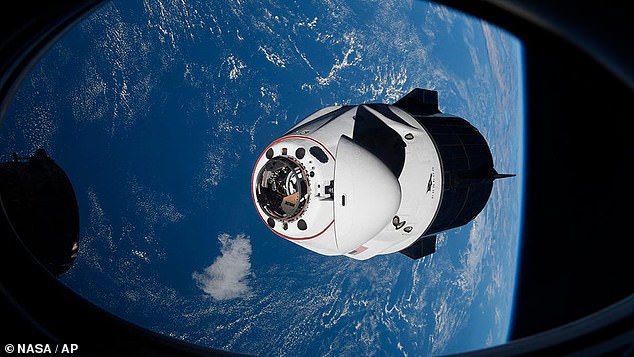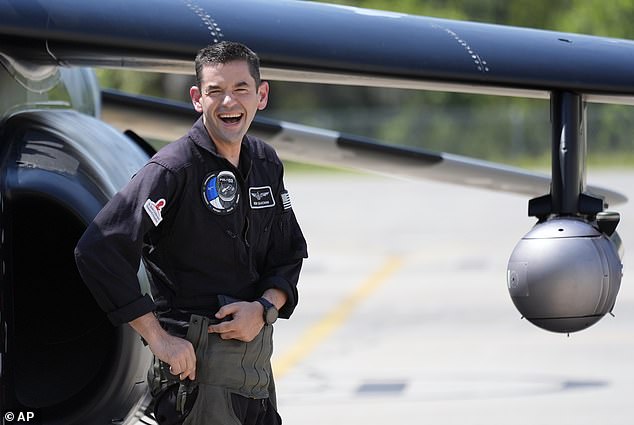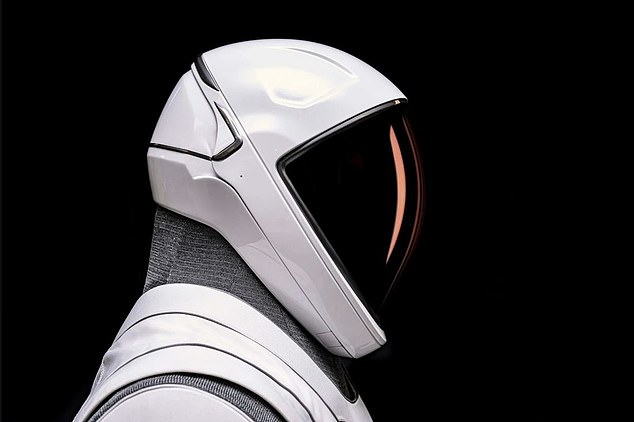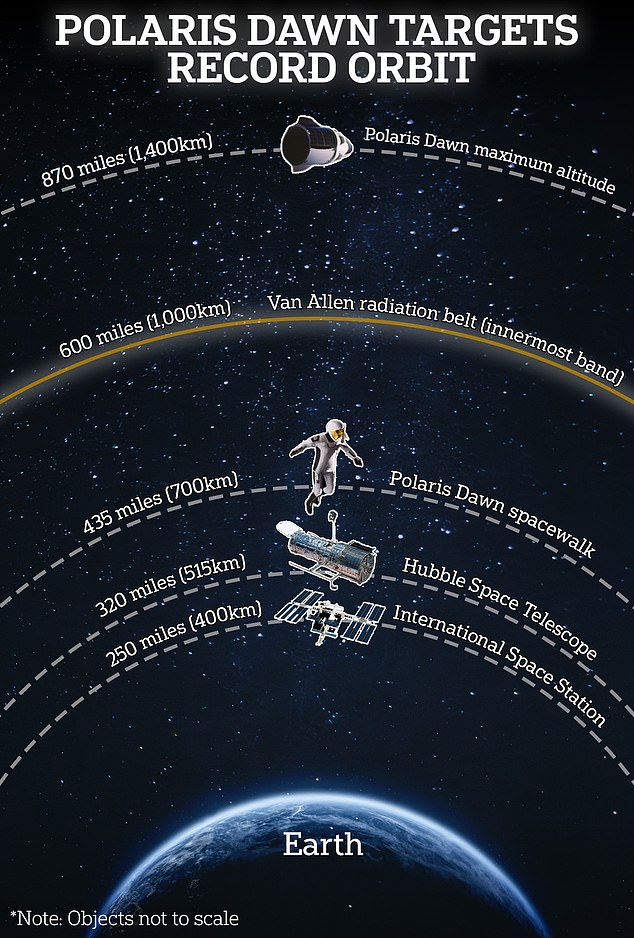The Potentially Deadly Risks of Elon Musk’s Billionaire-Funded Civilian Spacewalk
For the first time in history, two civilian astronauts will conduct a spacewalk from a commercial spacecraft.
SpaceX’s Polaris Dawn mission is a “first-of-its-kind” mission that will take four private astronauts further into space than humanity has traveled since the Apollo missions of the 1960s and 1970s.
On the third day of the mission, two crew members will travel into space. This is the first time a commercial spaceflight company has conducted a spacewalk.
But space safety experts warn that the crew faces potentially deadly risks from radiation exposure and rapid changes in pressure, which can cause life-threatening illnesses.
Polaris Dawn lifted off from Cape Canaveral, Florida, around 5:30 a.m. ET on Tuesday, carrying four American engineers and pilots – Jared Isaacman, who funded the trip, Scott Poteet, Sarah Gillis and Anna Menon – aboard SpaceX’s Crew Dragon capsule for a five-day orbit.
Isaacman, the founder of electronic payments company Shift4, funded the mission and chose his personal friend Poteet as the pilot.
He won’t say how much he spent, but it’s estimated at more than $100 million.
After launch, Crew Dragon will ascend to an initial orbit of 1,200 kilometers above Earth. Its thrusters will then fire to reach an altitude of 1,400 kilometers, further than any manned spacecraft has traveled since the moon landings.
The two-hour spacewalk will take place after the spacecraft descends to an altitude of about 430 miles on the third day of the mission, which is Friday.
When an astronaut takes a spacewalk on the International Space Station (ISS), he puts on his spacesuit and enters an enclosed space where the air is sucked out before the hatch opens.
This allows the astronaut to safely transition from the pressure of the ISS to the vacuum of space, without exposing the rest of the space station to that vacuum.
But the Polaris Dawn spacewalk will look very different.
The crew launched early Tuesday morning aboard a SpaceX rocket. They are scheduled for the spacewalk in two days

The crew consists of (left to right) Anna Menon, Scott Poteet, Jared Isaacman and Sarah Gillis
Although Isaacman and Gillis will participate in the spacewalk, the other two crew members – Menon and Poteet – will also have to don spacesuits.
Without an airlock, the entire interior of Crew Dragon would be exposed to the vacuum of space.
To do this safely, they first need to depressurize the entire spacecraft. After the spacewalk, they need to bring the pressure back to normal.
“They’re evacuating the entire Dragon,” independent space consultant Laura Forczyk told DailyMail.com.
“This is the first time this has been done on purpose.”
“So it is risky in that sense, but there are so many different precautions and redundancies that even though it is risky, it’s not overly risky,” she added.
After the spacewalk, Crew Dragon must be refilled with air and repressurized.
“If that system and the backup system don’t work, they have to come back with their spacesuits on. That’s something that’s never been done before,” Forczyk said.
But it is highly unlikely that either system will fail, so the chances of the Dragon crew having to remain in their spacesuits until they return to Earth are slim.
However, in the event of such an emergency, the crew has protocols in place that would allow it to return to Earth while evacuating Crew Dragon’s cabin, Forczyk said.

The Crew Dragon capsule does not have an airlock, making a spacewalk from this spacecraft riskier

Mission Commander Jared Isaacman is the only member of the Polaris Dawn crew to ever fly into space
However, navigating all these pressure fluctuations also comes with risks, space safety expert Tommaso Sgobba told DailyMail.com.
After the astronauts complete the spacewalk, they must gradually transition from the 5 pounds (2.27 kilograms) of pressure in their suits to the normal cabin pressure of 14.6 psi.
There is a chance they could develop decompression sickness, also known as “the bends,” he said.
This acute medical condition is caused by a rapid decrease in pressure in the body, causing nitrogen bubbles to form in the bloodstream. In some cases, it can be fatal.
To prevent decompression sickness, flight controllers conduct a 45-hour “pre-breathe” protocol prior to the spacewalk.
This increases the oxygen level in the cabin and slowly reduces the air pressure, removing nitrogen from the crew’s blood vessels.
And that’s not the only illness the crew has to worry about.
During space flight, some astronauts experience motion sickness, which can lead to vomiting, Sgobba said.

The other crew members’ lack of experience should not pose a significant risk, but they could suffer from motion sickness, making it impossible for them to wear their spacesuits safely.

The suits have been extensively tested on Earth, but there is always a risk involved in deploying life support technology for the very first time
Unless someone has been to space before, it is very difficult to predict whether he or she will be among these unlucky crew members, he added.
That’s important to know, because aside from Isaacman, none of the Polaris Dawn crew have ever traveled to space before.
“If you throw up now while you’re in the spacesuit, that’s the end of your story – your life story. You’re suffocating,” Sgobba.
So Isaacman—and especially Gillis, since this will be her first space flight—need to make sure they don their suits and leave Crew Dragon without any stomach problems.
But overall, the fact that the Polaris Dawn crew is civilian should not have a significant impact on the safety of the mission, Forczyk said.
“It’s not a problem. They’re so well trained by SpaceX,” she said.
The spacewalk will last approximately two hours, from opening the hatch to closing it and repressurizing the spacecraft.
But Isaacman and Gillis will each spend only 15 minutes outside the spacecraft. They will do so while tethered to their spacecraft by a 12-foot-long oxygen-carrying tether called an umbilical cord.
In the vacuum of space, they will rely entirely on their spacesuits for life support. The fact that these suits have never been used in space before adds another level of danger and risk, Forczyk said.
“Any new spacesuit that goes up that hasn’t been used yet, they want to make sure it’s working properly before they evacuate the Dragon,” she said.
The main difference between these suits and the suits used by NASA astronauts is the form of life support.
NASA astronauts carry their life support systems on their backs, while SpaceX suits provide life support via the umbilical cord attached to the space capsule.
The suits have been tested extensively on the ground, so extensively in fact that it delayed the launch of Polaris Dawn by two years, Forczyk said.

To reach its maximum altitude, the Polaris Dawn mission will have to pass through the Van Allen radiation belt, exposing the crew to extreme levels of space radiation
“The spacesuit was the main reason Polaris Dawn was delayed for so long,” she said. The mission was initially expected to launch in November 2022.
Sgobba does not believe the new suit design poses any additional risk to astronaut safety.
“The technology they’re using is the simplest technology they can use, and because it’s so simple, it’s also the safest,” he said.
The spacewalk will likely be the most dangerous part of the Polaris Dawn mission. But astronauts will face risks from day one.
To reach the mission’s historic heights, Crew Dragon must travel through Earth’s dangerous Van Allen radiation belt.
Upon entering the Van Allen Belt, the crew of four will receive “a hefty dose of space radiation; it is estimated that in a few hours they will receive as much radiation as they would receive in 20 years on Earth.”
NASA has said it is critical “to fly through this area quickly to limit radiation exposure,” but the Polaris crew will have to spend hours in the deadly radiation.
High doses of space radiation may increase the long-term risk of cancer in astronauts by damaging cellular DNA.
Cells will attempt to repair this damage, and sometimes they succeed. However, if the DNA is repaired incorrectly, it can lead to genetic mutations that can eventually lead to cancer.
Radiation can also alter the cardiovascular system by damaging the heart, hardening and narrowing arteries, and destroying cells in the walls of blood vessels. This damage can eventually lead to heart disease.
It also affects the brain. Exposure can impair neurogenesis, the process of generating new brain cells. This can lead to cognitive impairment and memory deficits.
NASA will use this mission to study the impact of high levels of space radiation on human health. But it will likely be years before the impact of this mission on the bodies of the Polaris Dawn crew is revealed.
Despite all the risks, it will be a major step forward for SpaceX if the crew of the Polaris Dawn can complete this mission safely, cementing their position as a leader in the commercial space race.
